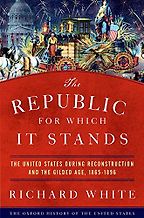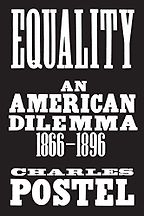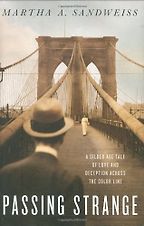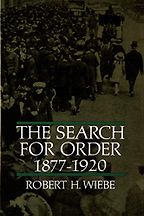Before we get to the books, the Gilded Age is our topic. Please define the phrase.
The Gilded Age refers to the period between the end of the American Civil War in 1865 and the beginning of the Progressive Era in the early 20th century. The phrase comes from Mark Twain’s novel The Gilded Age. In the 19th century, on the surface, everything appeared golden. The country was growing quickly in population and industrial capacity. But beneath the gilding was a society in turmoil. Things were getting worse for the majority of people. There was a lot of rot, a lot of corruption. That’s why the name Gilded Age stuck for the late 19th century.
The phrase suggests an era rife with materialistic excesses to me. How rapid was economic growth? How dramatic were the changes that were underway?
In 1865, the United States was coming out of the Civil War with an economy based largely on agriculture and small-scale production. At the turn of the 20th century, the United States was well on its way to becoming the world’s largest industrial nation. In 1865, the United States was largely rural and small town. By the early 20th century, most Americans live in cities. In the late 19th century, most Americans were independent producers and small businessmen. By the early 20th century, most Americans worked for wages. Virtually everything about the country changed during the Gilded Age, in ways nobody would’ve expected in 1865.
How was the Gilded Age different from the Victorian Age underway in the UK and from the Belle Epoque in France?
The Victorian period in Great Britain overlaps with the Gilded Age in the United States. The major difference is that Great Britain had undergone its industrial expansion well before the United States. The other great difference is that the United States was a democracy while Great Britain was still monarchical and aristocratic. Also, Great Britain already had a deep cultural past. The United States was sensitive about its lack of culture, even though the Gilded Age is a period of explosion in American arts and literature. Finally, British imperialism was going forward outside of its border, while American imperialism took place largely within its borders. The United States was still conquering much of its Western territory.
I insisted that you include your superlative survey of the period for the Oxford History of the United States among the five books we discuss about the Gilded Age. Let’s begin by talking about The Republic for Which It Stands.
Most of the books in the Oxford History of the United States series end on a triumphal note. The volume on the Revolution ends with establishing the Republic. The Civil War volume ends with emancipation and Union victory. My volume begins with the end of the Civil War, but then enters a period of great change and conflict. My volume ends in 1896, turmoil subsides but without any sort of triumphal note or any clear sense of what comes next.
The Gilded Age is so relevant to read about right now because it is so similar to the period we’re in. We’re in a period of great tumult, it’s hard to say whether we’re moving forward or moving backward.
In the book, you refer to the Gilded Age as ‘The Greater Reconstruction.’ What does that mean?
When I use the phrase ‘Greater Reconstruction’ I mean that the Reconstruction efforts that followed the Civil War were not confined to the South. There also was an attempt to reconstruct the Western United States and indeed even the Northern United States. The victorious Republican Party wanted to remake the entire country into a replica of Springfield, Illinois, Abraham Lincoln’s hometown. Reconstruction was an effort to make the United States a nation with no great differences in wealth—a largely small town and rural Protestant country, and a nation of roughly equal people.
“Virtually everything about the country changed during the Gilded Age”
As the victorious Republicans saw it, once we freed the slaves, once Reconstruction took place, once American farmers settled on the land Native Americans previously occupied, everybody in the United States would be roughly equal and the federal government would ensure that all Black and white men had the same political rights. That’s basically the vision they had for Reconstruction. And it failed. The great tragedy of Reconstruction is that it doesn’t secure Black equality or Black prosperity. Reconstruction fell far short of what the Republican Party intended in the South.
Equality: An American Dilemma 1866-1896, by Bancroft Prize-winning historian Charles Postel, seems to pick up on those points.
Charles Postel’s book takes on the meaning of equality in an industrial society. It looks at three organizations that were critical to the period, but which are largely forgotten today: the Grangers, the Knights of Labor, and the Women’s Christian Temperance Union. All of these organizations were interest groups in ways that will become familiar in the 20th century.
The Grangers, established when agriculture was the largest economic sector, fought to make sure that farmers retained a fair share of society’s profits. Grangers argued that what is good for farmers, in the end, will be good for America.
The Knights of Labor was a labor organization that objected to wage labor. They wanted to democratize American industry, so capital and labor cooperated in shaping work rules and distributing profits. The Knights wanted to transform the whole industrial system.
The Women’s Christian Temperance Union was led by a largely forgotten figure who was one of the most transformative reformers of the 19th century. Frances Willard argued that everything affecting the home should be subject to women’s influence. Alcohol consumption affected the home, so Willard started with temperance. Children were women’s charges, so schools should be shaped by women. The health of the home depended on women, so women must fight for clean and safe cities. Willard’s framework for women’s spheres of influence expanded endlessly. She made the Women’s Christian Temperance Union into an umbrella reform organization under which women lobbied for change throughout society.
Postel looks at these organizations’ attempts to remake America after the Civil War into one reconciled nation in which there is equality of opportunity and no great disparities of wealth. But the South resisted a vision of equality that included Black citizens. So, these reformers created a sympathetic vision of what the United States is supposed to be, but they undermined that vision by conceding to white supremacy.
Historians Charles and Mary Beard observed that fraternalism was a ‘general mania’ in late 19th century America. Postel calls the postbellum period ‘collective’ decades. Is this what he meant?
In the late 19th century, Americans were joiners. They joined all kinds of organizations. The Masons were one of the largest. Most Americans belonged to churches, largely Protestant churches, but also Catholic churches. All of the organizations I’ve talked about are burgeoning voluntary organizations. Most Americans, male and female, belonged to at least one of these organizations, which were influential and powerful.
The usual interpretation is that all these organization strengthened democracy, because they accustomed Americans to cooperating with each other. I am not so sure about that. How these organizations worked was not as simple as scholars often make it out to be. Many were not particularly democratic. Organizations such as the Masons were quite hierarchical. One of the great mysteries of the period is the social and political impact of fraternalism. It’s something I’m examining right now.
You’ve named one work of fiction among your books on the Gilded Age and it’s one of my favorites: A Hazard of New Fortunes by William Dean Howells.
William Dean Howells is not read much now, but he should be. He was one of the best-known writers of the time. A Hazard of New Fortunes may not be the greatest novel of the period, but it is quite important and very revealing. The plot is simple. Basil March and his wife Isabel are moving from Boston to New York where he becomes the editor of a magazine and is caught up in the social conflict of the period.
Howells has a wonderful eye. He makes the Marchs’ house hunt an exploration of late 19th century New York. He takes you on a walk from working class to rich areas of the city. He introduces you to a cast of characters that range from radicals to the new rich. Howells is scrupulously fair and sympathetic to almost everyone he writes about, even those who are unfair to others. Howells gives his readers a sense of what it was like to live in New York City in the 1880s, amid vast disparities of wealth, as great political conflicts opened up. That is the power of the book.
A Hazard of New Fortunes is known as the first novel of New York life. How central was New York to the Gilded Age and how did the Gilded Age help shape New York?
New York City, for Howells, was ‘the Great American City.’ During the Gilded Age, New York overshadowed all other American cities.
New York became central because it is where capital flows. As capital centralized, New York gained great influence over other parts of the country. People make their money all over the country, but as inequality grows during the Gilded Age, the upper crust of society centers itself in New York.
Get the weekly Five Books newsletter
The second reason New York became central was its diversity. New York was where immigrants from all over the world came. During the Gilded Age, New York was an industrial city. It was filled with mid-sized factories and workshops. New York became a place where the working poor congregated.
The rise of a wealthy elite and the rise of wage labor came together in New York. In the 1870s and 1880s, before Brooklyn and Queens were incorporated into New York, these two groups were concentrated in Manhattan. New York City became one of the most densely populated places in the world; great wealth and great poverty rubbed right up against each other.
The Gilded Age was a period of accelerated industrial development when the finance industry became more concentrated in New York.
The finance industry grew out of the Civil War. The Union fought on borrowed money. After the Civil War, the government no longer needed small savers to buy bonds to finance the federal government. So, banks turn to selling bonds to finance railroads and other enterprises expanded along with them.
In the late 19th century, the United States built great railroads, which became the first large joint stock corporations. Nobody had the individual wealth to build these enterprises; they depended on borrowed money.
During the Gilded Age, London rather than New York was the world financial center. But New York was the financial center of the United States. There is capital in Boston, Philadelphia, Chicago; but the real money was in New York. It’s not so much the stock market as the bond market that developed in 1870s and 1880s New York. Then, in the 1890s, when the corporate model expanded to all sorts of enterprises, New York becomes even more important.
Next is a work of nonfiction. Please tell me about Princeton historian Martha A. Sandweiss’s Passing Strange, winner of the National Book Critics Circle Award.
I admire this book a great deal. It uses a fascinating story to illuminate the entire society. The central character is a white man named Clarence King who was born to wealth and privilege. He was one of the famous figures of the Gilded Age, an explorer, a scientist, and a bestselling author. He knew everybody from the top of society to the bottom.
King was known among his friends as a bachelor who had romantic liaisons with a wide range of women. What almost no one knows is that King married Ada Copeland, a Black woman who was born into slavery in Georgia. Ada believed Clarence to be an African American Pullman porter named James Todd, whose frequent absences were explained by his railroad work. So King, a patrician white public figure, privately passed as Black and had five mixed race children. The book revolves around their incredibly complicated life together. The story is fascinating, the characters are fascinating, and it’s just a wonderful piece of work.
What does Passing Strange reveal about both the fluidity and the rigidity of Gilded Age society?
We think race was an impermeable boundary in the age of Jim Crow. The Gilded Age becomes the age of the ‘one drop rule.’ Marni Sandweiss uses this story to show us that there was mixing, and that people passed color lines for all sorts of reasons. In Gilded Age society, elites enjoyed the social possibilities of poorer urban areas. Passing Strange makes clear that racism is real but that racial categories are artificial and often outwitted throughout history, including during the Gilded Age.
Finally, The Search for Order, a synthetic 1967 survey by historian Robert Wiebe.
Republic for Which it Stands is partially in reaction to this book. The Search for Order is one of those history books that seemed to define a period so thoroughly that other historians avoided the topic for decades after its release. People use Wiebe from the 1960s through the early 21st century.
According to Wiebe, the real story of this period is how the United States went from being loosely connected local communities to becoming one national community; it changed from the fragmented nation it had been before the Civil War into one modern nation with a new middle class. It’s a story with a simple overarching thesis and almost too much detail.
Five Books interviews are expensive to produce. If you're enjoying this interview, please support us by donating a small amount.
But Wiebe didn’t have the evidence to sustain many of the assertions that fed his thesis. Many of the things which he said happened in the Gilded Age had happened earlier and other things didn’t happen at all. Nonetheless, it’s a great feat of storytelling to fit so many disparate details into a simple framework. Even though I disagree with Wiebe, I always keep my eye on The Search for Order as a model of historical writing.
The Search for Order presents the Gilded Age as paving the way for the Progressive movement of the 20th century. How does the Gilded Age connect with what came next?
Wiebe argues that the growth of expertise and the breakup of island communities is the real beginning of the Progressive Era. I argue that the Progressive Era is quite distinct. During the late 19th century there is a belief that the whole country can be democratized, including the economy, and that if we fail to democratize the economy and the society, the United States is going to split apart at the seams. Wiebe and others project progressive beliefs about managing strife with only minor changes back onto the 19th century. I believe that the failure of 19th century reforms, wrecked on the shoals of xenophobia and white supremacy, prepared the way for the Progressive Era but that the Progressive movement only took root because more radical reforms failed.
Earlier, you mentioned that we have much to learn from the Gilded Age because it has many things in common with the current period. How does the Gilded Age help us understand the 2010s and 2020s?
If you search United States history for a time when there were problems similar to ours, I can’t think of a better period than the Gilded Age. The Gilded Age is the beginning of the great era of immigration in the United States, which exploded following the Civil War. If you are looking for a time when fear of cultural changes threatened to tear the US apart, go back to the Gilded Age. Elites feared that the influx of Catholics was undermining American schools, the Protestant churches, and the principles of American governance. Reconstruction was launched with transformative intentions but failed. Similarly, if you want to look at a period when the US is adjusting to ethnic diversity and wrestling with historic injustices, look at the Gilded Age.
I could go on and on and on in outlining the parallels between the present and the Gilded Age. If you think that our democracy cannot endure with the economic inequality that afflicts the 21st century, go back to the Gilded Age, when Americans worried that the nation could not stand with the economic inequality that arose in the late 19th century. If you think that the nature of work is changing dramatically, go back to the Gilded Age, when the economy was transformed. If you worry that changes in the environment are threatening health and humanity, go back to the Gilded Age when urbanization and industrialization gave birth to those worries. These parallels allow us to step back from the concerns we’re immersed in now and think about our world in new ways. The long lens of history shows us what we’re too myopic to see in the present.
Interview by Eve Gerber
March 26, 2021. Updated: March 29, 2021
Five Books aims to keep its book recommendations and interviews up to date. If you are the interviewee and would like to update your choice of books (or even just what you say about them) please email us at [email protected]










